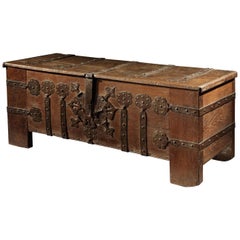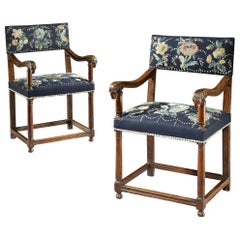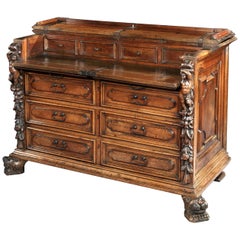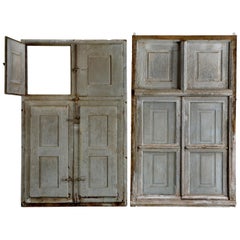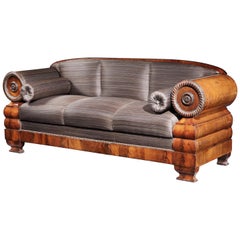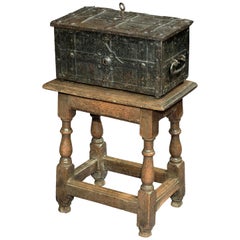Howgego Historic & Modern Furniture
to
551
523
22
6
114
82
33
32
20
13
9
9
4
2
2
2
2
1
1
1
202
107
214
28
23
73
48
9
4
5
5
3
24
28
9
17
17
201
121
79
61
56
506
281
235
62
59
551
550
550
4
2
2
2
1
Chest or Stollentruhe, Early 16th Century, German Gothic, Oak Chest, Original
Located in BUNGAY, SUFFOLK
This standing chest is of clamp-front construction, extensively decorated with long, ironwork straps with quatrefoil finials which ‘wrap’ around it, and has an ornate, central lockplate, and front legs with full, height stiles. The ironwork straps and finials are fixed with convex, headed nails: running along the front, five long straps; the two side straps; and the five straps on the top. On the chest front, centrally placed, is a large, iron lockplate with four outer, radiating spade finals in each corner and three, superimposed spade finials (a symbol of nobility) which are pierced with the initials ‘BB’. The lockplate receives a corresponding, external hasp fitted to the lid. Below the floor of the chest, the two front stile legs retain most of their original height. The lid is supported by substantial iron strap hinges that extend right down the back of the chest. Inside the chest at the left end is a shallow, oak till.
Construction The chest is of joined, 'clamp-front' construction, reinforced by the nailed, iron mounts. In total it uses ten, oak boards which were riven and planed. The back and front are each formed from a large single plank held to the full height stiles by long, pegged tenons. The sides are also single boards joined into the stiles using long tenons held by dowels, and extend down below the chest bottom, concealing the ends of the bottom boards. The bottom consists of a single board cut into the sides and shallow rebates in the stiles. The front and back boards are dowelled into the bottom boards. The lid which overhangs the sides has a narrow cleat at each end, and consists of one wide plank which has bowed a little as a result of shrinkage.
Ironwork : The wrought ironwork straps, lockplate, hasp and lock all appear all appear to be early, and of the same original manufacture and are fixed with convex headed nails. There is mild dark staining of the oak around the iron mounts, possibly because of low tannin content in the oak.
Length 172 cm., 67 ¾ in., Height 71.5 cm., 28 ¼ in., Depth 63 cm., 24 ¾ in.,
Related to: No 900:2-1904 V&A Museum, London. Stadtmuseum Dusseldorf. Decorative Arts Museum Berlin. Museen Schleswig-Holstein & Hamburg. A related example featuring elaborately-carved feet and formerly in the Horsham Museum, West Sussex, sold at Christie's in 2010 for £97,250 and another example, again with carved feet sold at Sothebys in 2006 for £48,000.
Literature: A similar example is illustrated in H. Lüttgens, Alt- Aachener Wohnkultur; Ein Rundgang durch ein altes Aachener Haus im Wohnstil des 18. Jahrhunderts, Aachen, n.d., ill. 12, and another comparable iron-bound chests...
Category
Antique 16th Century German Gothic Blanket Chests
Materials
Oak
Pair of Walnut Armchairs, Late 16th Century, French Renaissance, with Ram Mask C
Located in BUNGAY, SUFFOLK
"This rare pair of upholstered open armchairs relate to examples in museum collections in France, the USA and the UK. Few pieces of Renaissance furniture featuring ram’s head motif arm terminals survive as the chairs would have been in the ownership of the elite symbolising leadership and authority. The condition of these armchairs reflects their age and use and they have a rich colour and lustrous patina.
The form of these chairs is characteristic of a stereotypical Renaissance model. The upholstered section of the backs are upholstered in wool with applied 17th century floral needlework faced with gilded studs and supported by square section uprights. The channelled tablet and stylised rosette incised curved arms terminate in acanthus capped carved rams' masks and are supported by column turned uprights headed by an entrelac collar. The ram is a symbol of leadership and authority and it also determination, action, initiative, and Aries, the first sign of the Zodiac. The seats are upholstered in wool with applied 17th century needlework faced with gilded studs and supported by tapering column/ring turned front legs and square section back legs. Some of the stretchers with moulded detailing. Standing on front ball feet. Exceptional original colour and patina. Henri II 1550-60.
Condition: The chairs are both sturdy with exceptional colour and patina. One armchair with a splice on the rhs back leg and replaced but period front and lhs stretcher both bearing old nail marks, two other replaced stretchers and the back uprights bearing old nail marks indicating that they were upholstered at some point. The other armchair with an old repair to a break in the right back leg and an old patch near the end of the leg, replaced but period back and lhs stretcher, small patch to bottom of lhs arm where it meets the support. Old worm marks and some losses. Considering the age of the armchairs, these repairs and replacements are not unusual and consistent with the repairs on the related armchairs in museum collections. They suggest that the chairs either fell backwards at some point or someone leant back while sitting in them.
Back Height 107cm, 42in, Seat Height 59.5cm, 23½in
Width 60cm, 23½ in, Seat 59cm, 23¼in
Depth including arm 59cm, 23¼in, Seat 49cm, 19¼in
Provenance: Deaccessioned by The National Galleries of Scotland
Bearing an old transport label from Alain Moatti (French architect) to Mrs Katz, London
Literature: Related to :
There are comparable armchairs in international museum collections dated to the second half of the 16th century. Most share the following characteristics with the above pair, the form, the ram's mask carved to the end of each arm, the curvilinear outline of the arm rests, the ring turned front legs as well as the plain square section back legs and plain stretchers.
1. Two stained glass windows...
Category
Antique 16th Century French Renaissance Armchairs
Materials
Walnut
Cassettone Bureau-Chest Bambocci 16century Italian Renaissance Walnut Lombardy
Located in BUNGAY, SUFFOLK
AN EXCEPTIONAL MUSEUM QUALITY, ITALIAN, RENAISANCE WALNUT CASSETTONE WITH A FITTED BUREAU IN THE UPPER PART & EXCEPTIONAL BAMBOCCI CARVING, LOMBARDY
- This exceptionally rare, museum quality, piece of early furniture was conceived and crafted as an artwork of the finest quality of its time. Throughout time it has been a luxurious, statement piece which has protected it, and fortunately it has survived in virtually, original condition.
- This magnificent cassettone exudes the character and quality of the finest, late-Renaissance furniture.
Northern Italian Renaissance furniture often had the sides, legs or angles, 'a Bambocci', incorporating carved figures which were considered unique sculptures in their own right.
- The putti on this cassettone are beautifully carved and of sculptural quality. Each angel has one arm raised to heaven, a poignant touch.
- The lion’s paw feet are a classical feature and make a great statement.
- This cassettone was conceived to have visual impact through the quality of the carving, as well as being very practical with the writing compartment fitted in the top part.
- It has survived in very original condition with a few small repairs and losses, and the colour and patina are warm and lustrous.
- This cassettone is illustrated Illustrated in C. Alberici, Il Mobile Lombardo, Milan, 1969, p. 45, one of the seminal works on Lombardy furniture, and has been in two renowned collections.
The hinged top in two sections faced with a solid moulded edge. The front part has a fall front and opens to reveal a writing compartment. The fall front retains its original lock and is concealed with a false drawer which is above three drawers. All with moulded panels, escutcheons and retaining the original iron handles. The front ends have exceptional, bambocci, carved putti raising their arms to heaven above trailing foliage. Standing on magnificent lion's-head carved feet. The sides are panelled. Exceptional original colour and patina.
Literature : Illustrated in C. Alberici, Il Mobile Lombardo, Milan, 1969, p. 45. A Gonzalez-Palacois, Il mobile in Liguria, Genova, 1996 illustrates related pieces
Measures: Length 147 ½ cm. 58 in, height 104 cm. 41 in, depth 75 cm. 29½ in,
Provenance: Coll. Private Azzate The Collection of Sandro and Lidia Orsi, Ca’ Mera, Varese. Regarded as one of the most beautiful homes in Lombardy, Ca’ Mera, the country house of Sandro and Lidia Orsi was filled with beautiful objects from many different epochs. A renowned antiquarian from Milan, over his lifetime Sandro and his wife Lidia revived the Renaissance and Baroque character of the house and instilled their own unique vision into the interiors, which culminated with the creation of a Kunst – or Wunderkammer. “I have never seen such an example of poetical taste”, Sir John Pope...
Category
Antique 16th Century Italian Renaissance Commodes and Chests of Drawers
Materials
Walnut
Pair of Windows, 17th Century Flemish Baroque, Original Shutters & Ironwork
Located in BUNGAY, SUFFOLK
Exceptionally Rare Pair Of 17th Century, Flemish, Windows, 17th Century Flemish Baroque, Original Limewash, Shutters, Glazing & Ironwork
These windows have come from the property th...
Category
Antique Early 17th Century European Baroque Windows
Materials
Oak
Settee 3-Seat Early 19th Century French Empire Mahogany Upholstered in Horsehair
Located in BUNGAY, SUFFOLK
This handsome settee is in rare original condition retaining all the original timber and horsehair stuffings. The form is bold and fluid and the carved ornament very well executed. T...
Category
Antique Early 19th Century French Empire Settees
Materials
Mahogany
Stool, Mid-17th Century, English Charles II, Oak
Located in BUNGAY, SUFFOLK
United with a mid-17th century rustic oak stool table. The plank top with a moulded edge. Two sets of metal nails and another set of screws show where it has been secured at differen...
Category
Antique Mid-17th Century British Charles II Stools
Materials
Oak
Table Gateleg, Early 19th Century, English Regency, Mahogany 6-Seat
Located in BUNGAY, SUFFOLK
The top in three sections, each made from one piece of solid timber with flame figuring 2 cm., 0.75 in thick. The hinges original. The frieze plain. Standing on elegant tapering legs...
Category
Antique Early 19th Century British George IV Center Tables
Materials
Mahogany
Cathedra or Throne Chair, Late 16th Century, French Second Renaissance, Walnut
Located in BUNGAY, SUFFOLK
A moulded cornice sits above the high, panelled back with fluting and applied roundels. The later, metal pin on the left edge releases the central, moulded panel in the back which retains its original hinges. When the pin is removed the panel can be lowered, revealing a large area behind. The scroll arms are supported by tapering turnings which can be compared with mid-16th century benches of the nave such as those in the churches in Gerberoy and Coivrel which are in Oise, the Piccardie region of Frances.
The panelled, box seat has later 18th century hinges...
Category
Antique 16th Century French Renaissance Armchairs
Materials
Walnut
Cosmgraphy and Astrology, 1686 by Richard Blome from the First Edition
By Richard Blome
Located in BUNGAY, SUFFOLK
Cosmography & Astrology
Large oval engraved plate with inscriptions outlining the various parts of cosmography and astronomy; below, two emblematic figures with scientific instruments either side. Lettered with title, dedication, and various inscriptions. To his Excellency Roger Palmer, Earle of Castelmain and Baron of Limerick in Ireland, Embassador Extraordinary from his majesty King James II to his Holyness Pope Innocent 11th anno dom 1686. This plate is humbly DD by Richard Blome. On paper and retaining its original coloring.
Sheet width 26 ½ cm., 10 ½ in., height 41 ½ cm., 16 ½ in.,
In a part-gilded Sansovino frame...
Category
Antique 1680s English Charles II Decorative Art
Materials
Paper
Pair Beds Tester 19c American Colonial-Style Mahogany Douglas Fairbanks Pickfair
Located in BUNGAY, SUFFOLK
This pair of half-tester beds were acquired for the guest suite at Douglas Fairbanks Sr and Mary Pickford’s Beverly Hills estate, Pickfair, which housed a collection of early 18th century English and French period furniture, in the 1920s. Life Magazine described Pickfair as 'a gathering place only slightly less important than the White House, and much more fun.'
The beds passed by descent to Douglas Fairbanks Jr. and in family tradition were used as the main guest beds at his farm in Virginia, subsequently his home in Washington, then Westridge in Pacific Palisades, Los Angles until 1948 when the family moved to No 8 The Boltons in London and finally in 1973 to the ‘Vicarage’ in Palm Beach. They were inherited by his daughter Daphne in 1988 who continued the family tradition using them as guestbeds at her homes in London and Suffolk. Daphne is now 73 and when she downsized she gave the beds to her granddaughter AIslinn, the great, great grandaugher of Douglas Fairbanks Sr, who had “always loved these beds”. There is a photograph of the beds at Pickfair amongst the family papers which they are trying to locate. Daphne Fairbanks has written a letter discussing their history and some of the stars who slept on them which will pass with the beds :
‘I should think almost every well known person in the film industry slept on these beds ‘
Aside from being exceptionally rare as antiques, these beds represent a unique opportunity to acquire an iconic piece of history from the golden age of movie making having been owned the “King of Hollywood” and slept on by countless stars, politicians, royalty and socialites. They have passed through 5 generations of the Fairbanks dynasty who have continued the family tradition of using them as their main guestbeds.
The turned posts are surmounted by finials and have fine, reeding and carved decoration. The shaped headboards have scroll crestings above strikingly, beautiful, figured veneers The rails are also veneered The ends have a finely, carved turned rail. The beds stand on lion's paw feet. Two of the original castors remain. The colour and patina are exceptional.
These pieces do not require a Cites certificate, they are not made from Swietenia humilis.
Measures:
Height to top of finials 193 cm., 76 in., to top of siderails 18 in., to mattress slats 14 ½ in.
Overall Length 213 cm. 84 in., internal headboard to footboard 77 ½ in, internal to siderail & corner cut-out 75 ¼ in.,
Overall Width 109 cm., 43 in., outside rail to outside rail 41 ¾, internal width 39 3/8 in
Pickfair, 1143 Summit Drive, Beverly Hills, California, 90210
In the 1920s, the two most famous homes in America were Pickfair and the White House. Silent film superstars Mary Pickford, 'America's Sweetheart,' and dashing Douglas Fairbanks were the original Hollywood super couple. Individually, they were wildly famous the world over, even more so when they fell in love and married. Douglas had bought the property in the Hollywood hills which they made their home and which the press christened Pickfair, combining their last names, which stuck. They created a romantic legend that drew a steady stream of international royalty, politicians, scientists and artists. An invitation to the Pickfair mansion meant you had made it in Hollywood.
Located at 1143 Summit Drive, in San Ysidro Canyon in Beverly Hills, the property was a hunting lodge when purchased by Fairbanks in 1919 for his bride, Mary Pickford. The newlyweds extensively renovated the lodge, transforming it into a 4-story, 25-room mansion complete with stables, servants quarters, tennis courts, a large guest wing, and garages. Remodeled by Wallace Neff in a mock tudor style, it took 5 years to complete. Ceiling frescos, parquet flooring, wood panelled halls of fine mahogany and bleached pine, gold leaf and mirrored decorative niches, all added to the authentic charm of Pickfair. The property was said to have been the first private home in the Los Angeles area to include an in-ground swimming pool, in which Pickford and Fairbanks were famously photographed paddling a canoe.
Pickfair featured a collection of early-18th century English and French period furniture, decorative arts and antiques. Notable pieces in the collection included furniture from the Barberini Palace and the Baroness Burdett-Coutts estate in London. The highlight of any visit to Pickfair was a large collection of Chinese Objects d'art collected by Fairbanks and Pickford on their many visits to the Orient. The Pickfair art collection was wide and varied and included paintings by Philip Mercier, Guillaume Seignac, George Romney, and Paul DeLongpre. The beds were acquired for the bedroom suite in a new, guest wing.
The mansion also featured an Old West style saloon complete with a burnished ornate mahogany bar obtained from a saloon in Auburn, California as well as paintings by Frederic Remington. In the 1970 Volume 2, Number 10 issue of Mankind Magazine it states there were twelve Remington's from 1907 purchased from the Cosmopolitan Publishing Company that 'were Mary Pickford's gift to her husband, Charles 'Buddy' Rogers.' The interiors of Pickfair were decorated and updated throughout the years by Elsie De Wolfe, Marjorie Requa, Tony Duquette, and Kathryn Crawford.
During the 1920s the house became a focal point for Hollywood's social activities, and the couple became famous for entertaining there. An invitation to Pickfair was a sign of social acceptance into the closed Hollywood community. Dinners at Pickfair were legendary; guests included Charlie Chaplin (who also lived next door), the Duke and Duchess of Windsor, Greta Garbo, George Bernard Shaw, Albert Einstein, Elinor Glyn, Helen Keller, H.G. Wells, Lord Louis Mountbatten, Fritz Kreisler, Tony Duquette, Amelia Earhart, F. Scott Fitzgerald, Joan Crawford, Noël Coward, President Franklin D. Roosevelt and Eleanor Roosevelt, Pearl S. Buck, Charles Lindbergh, Max Reinhardt, Sir Arthur Conan Doyle, Thomas Edison, Lillian Gish, Gloria Swanson, the Duke and Duchess of Alba, the King and Queen of Siam, Austen Chamberlain, Vladimir Nemirovich-Danchenko, and Sir Harry Lauder. Lauder's nephew, Matt Lauder Jr., a professional golfer whose family had a property at Eagle Rock, Los Angeles, California, taught Fairbanks to play golf.
When Fairbanks and Pickford divorced in January 1936, Pickford resided in the mansion with her third husband, actor and musician Charles 'Buddy' Rogers, until her death in 1979. Pickford received few visitors in her later years, but continued to open up her grand home for charitable organizations and parties. In 1976 Pickford received a second Academy Award for Lifetime Achievement in Film. The Honorary Oscar was presented to her in the formal living room of Pickfair, and televised on the 48th Academy Awards. Introduced and narrated by Gene Kelly, it provided the public a very rare glimpse inside the fabled mansion.
Empty for several years after Pickford's death, Pickfair was eventually sold to Los Angeles Lakers owner, Dr. Jerry Buss, who continued to care for the home, updating and preserving much of the unique charm of Pickfair. In 1988 it was purchased by actress Pia Zadora and her husband Meshulam Riklis who demolished Pickfair replacing it with a large 'Venetian style palazzo'. They received harsh criticism from a nostalgic public, including Douglas Fairbanks Jr who was quoted in the LA Times, 'I regret it very much. I wonder, if they were going to demolish it, why they bought it in the first place.'. The only remaining artifacts from the original Pickfair are the gates to the estate, the kidney-shaped pool and pool house, remnants of the living room, as well as the two-bedroom guest wing, which the beds were acquired for and, which played host to visiting royalty and notable film celebrities for over half a century. The guest wing was once used as a honeymoon suite for Lord Louis and Lady Mountbatten...
Category
Antique Mid-19th Century North American American Colonial Beds and Bed F...
Materials
Mahogany
Knole Settee, Cowdray Park, English, Lengyon & Co, olive velvet, tapestry
Located in BUNGAY, SUFFOLK
- EXCEPTIONALLY, RARE, MUSEUM QUALITY PIECE, THE COWDRAY PARK KNOLE SETTEE, INVENTORY NUMBER D2029
- Supplied by Lengyon & Co, the pre-eminent maker, to ...
Category
Early 20th Century English Charles II Settees
Materials
Tapestry, Velvet
